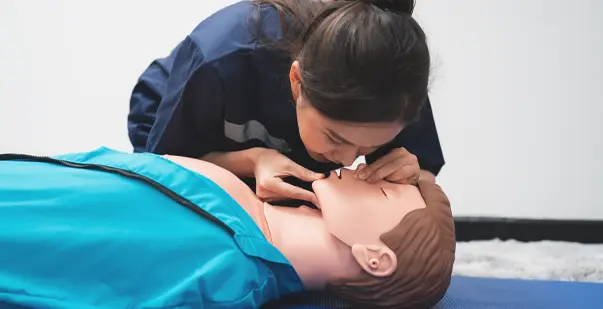Table of content
- Introduction
- What are rescue breaths?
- When to give rescue breathing, and when must you avoid it?
- Four ways to give rescue breaths
- Conclusion
Rescue breathing is a lifesaving technique and involves exhaling into the airway and lungs of a person who has stopped breathing. The person performing rescue breathing takes several steps, such as checking whether the person is conscious and removing obstructions on the way.
The steps depend on whether a person delivers rescue breathing as part of CPR and whether they are in distress or not. Learn the different ways to give rescue breaths to a person.
Master ACLS Now
Get ACLS certified with confidence
What are rescue breaths?
Rescue breaths are crucial when somebody needs help with ventilation. It is not that they are not breathing or not adequate to support life. Provide assistive ventilation because, without adequate oxygenation, your brain loses 10 percent every minute it loses out oxygen.
It is a first aid technique a person can use on someone who has stopped breathing. It was previously known as mouth-to-mouth resuscitation and involves blowing air into a person’s mouth to keep them oxygenated. Cardiopulmonary resuscitation may involve rescue breathing and sometimes chest compressions.
When to give rescue breathing, and when must you avoid it?
A person may need rescue breathing in the following instances:
- During choking
- When one ingests poison has a severe asthma attack
- Breathes in carbon monoxide
- Experiences drug overdose
Additionally, a person may perform rescue breathing without chest compressions when someone is unconscious and not breathing but has a pulse. If a person does not have a pulse, they need CPR involving chest compressions and rescue breathing.
If a person is experiencing cardiac arrest, the industry guidelines recommend that only certified rescuers perform rescue breathing. It expands the chest and stops blood from flowing to the heart.
Four ways to give rescue breaths
Rescue breaths are a crucial part of someone’s life during a medical emergency such as choking. When someone’s breathing has stopped, you must deliver rescue breaths until an ambulance arrives.
- Mouth to mouth: There are four different ways to deliver breaths. Mouth-to-mouth is the most common method that usually comes first to the mind. It is more popular among individuals. Some people often confuse this technique with CPR, as it can be a part of performing CPR.
To give ventilation mouth to mouth, pinch the nose to keep air from escaping that way. Tilt the head back to open the airway and give breaths mouth-to-mouth. While performing this, look to see the victim’s chest rise. As soon as you witness the chest rising, stop and give a second breath.
You must give breaths every 5–6 seconds for infants. For children and rescue breaths on an adult, give 2-3 seconds. The mouth-to-mouth technique is suitable when there is no airway protection.
- Pocket masks: The best way to deliver ventilation is by using a pocket mask. These come in hard-case little containers that can be stored anywhere, such as your home, car, or office. To use the pocket mask, you will pop them up to put the valve into position.
The valve is one way that prevents secretions or bodily fluids. You can blow into the mask, but nothing can come out. To put the mask in position, you will take the narrow part of the mask and place it on the bridge of the nose, pushing down. Take your index finger and thumb and push down the four corners of the mask.
Then take the three fingers and grab the forehead. Follow this process by grabbing the chin and tilting back. Blow air into the mask and wait for the chest to rise. You do not want to over inflate or over oxygenate.
- Bag mask: This is the third way to give rescue breaths. The use of a bag mask is the most popular way of giving ventilation for anyone in healthcare. The bag valve mask can connect to oxygen and allows victims to receive a higher concentration of oxygen. Additionally, bag masks give you more space from the patient.
Bag masks are used from the head of the patient, not from the side. You will place the bridge of the patient’s nose at the narrow part of the mask. You will grab your hand and cup it all the way around the face and the mask while tilting the head back. Look for the victim’s chest to rise.
Squeeze half of the bag. Additional air does not help the victim but can cause hyperventilating. You can get these masks in varying sizes for an adult, a child, and an infant. You can use the adult bag mask on anyone.
- Endotracheal Tube (ET’s): The final tool that can be used for giving rescue breaths is an ‘ET’ or endotracheal tube. These are more common in hospital settings. Sometimes paramedics use this in an ambulance. This enters the mouth to give a direct airway to the trachea.
While delivering air with a bag, mouth-to-mouth breaths, or pocket mask, air is reaching more places than just the lungs. A little bit of air reaches the stomach, and a little bit is going to the lines. It isolates the airflow directly into the lungs.
Conclusion
These four are popular methods of performing rescue breaths on an adult victim. It is crucial to perform the type that you have received training in. CPR is a lifesaving first aid procedure that improves someone’s chances of surviving if they suffer a heart attack or stop breathing following a trauma.
The steps tend to vary depending on whether the person is a child, infant, or adult. However, the basic cycle of chest compressions and rescue breaths will remain the same.







